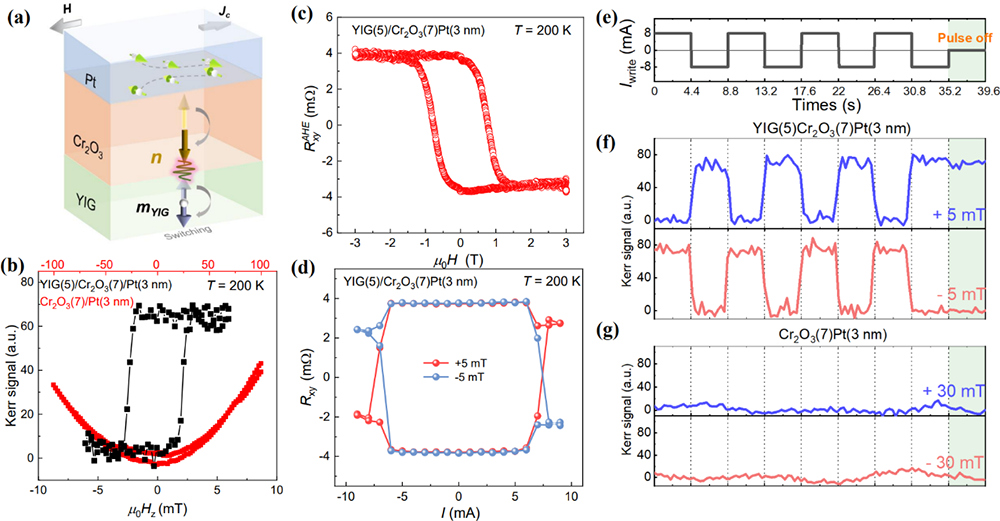Current-Driven Perpendicular Néel Vector Switching in Collinear Antiferromagnets
Date:08-10-2024 Print
Antiferromagnets (AFMs) exhibit unique characteristics, such as zero net magnetization and the absence of stray magnetic fields, with intrinsic resonance frequencies in the terahertz (THz) range. These properties make AFMs highly promising for developing next-generation spintronic devices like magnetic random-access memory (MRAM), offering resistance to external magnetic field interference, high stability, density, and speed. AFMs can be categorized into collinear and non-collinear types based on their spin alignment. Unlike non-collinear AFMs, which have multiple easy axes, collinear AFMs possess only two stable Néel vector states, analogous to the two magnetization directions (up and down) of ferromagnets, enabling direct encoding of binary "0" and "1" information. Furthermore, collinear AFMs with perpendicular magnetization exhibit higher magnetic anisotropy energy barriers, ensuring more stable and longer-lasting data storage. The strong exchange interaction between adjacent magnetic moments in collinear AFMs also supports high-frequency spin dynamics, essential for ultra-fast spintronic devices. Therefore, achieving 180° switching of the Néel vector in collinear AFMs using spin-orbit torque (SOT) forms the fundamental physics for realizing fully electrically written AFM memory technology.
In 2023, the M02 group at the Institute of Physics, Chinese Academy of Sciences, and the Beijing National Research Center for Condensed Matter Physics achieved 180° switching of the perpendicular Néel vector in a collinear antiferromagnetic insulator Cr2O3 driven by SOT for the first time. By measuring the anomalous Hall resistance generated by uncompensated magnetic moments at the interface, they effectively read the direction of Cr2O3’s Néel vector. The study demonstrated that the SOT generated by current could efficiently drive 180° Néel vector switching. At 270K, the critical switching current density was 5.8×106 A/cm², which is an order of magnitude smaller than that in other AFM insulators. Furthermore, due to the THz-range intrinsic frequency of Cr2O3, they achieved ultra-fast 180° switching of the Néel vector under short current pulses (6ns) in Cr2O3/Pt heterostructures.
In addition, the researchers achieved simultaneous 180° switching of the Néel vector in Cr2O3 and the perpendicular magnetization in YIG in Y3Fe5O12/Cr2O3/Pt heterostructures. Exchange bias measurements revealed strong interfacial exchange coupling between Y3Fe5O12 and Cr2O3. When current was applied to the Pt layer, the SOT-driven switching of the perpendicular Néel vector in Cr2O3 also induced the magnetization reversal of YIG. This experiment confirmed that the 180° switching occurred throughout the entire Néel vector in Cr2O3, not just in the uncompensated interfacial spins.
The mechanism of SOT-induced perpendicular magnetization switching in ferromagnetic insulators mediated by antiferromagnetic insulators, along with the previously developed novel magnon valve [PRL 120 (2018) 097205], magnon junction [PRB 98 (2018) 134426;Nature Electronics 3 (2020) 304], and magnon transistor [PRB 93 (2016) 060403; PRL 132 (2024) 076701], all with Chinese independent intellectual property rights, lays the foundation for the development and practical application of next-generation magnonic information science and technology.
This research has been published under the title "Electrical switching of the perpendicular Néel order in a collinear antiferromagnet | Nature Electronics" in the latest issue of Nature Electronics. Ph.D. students He Wenqing and Zhang Tianyi from the M02 Group, along with Zhou Yongjian from Tsinghua University, are the co-first authors of the paper, while Prof. Han Xiufeng and Associate Prof. Wan Caihua served as co-corresponding authors. Other collaborators contributed to device fabrication, testing, theoretical analysis, and manuscript preparation. This work was supported by the National Natural Science Foundation of China (NSFC) and the Ministry of Science and Technology's key R&D projects, and Chinese Academy of Sciences.

Figure 1. SOT-driven Néel vector and perpendicular magnetization switching in YIG/Cr2O3/Pt heterostructures. (a) Schematic of AFM-mediated switching in YIG(5)/Cr2O3(7)/Pt(3nm) heterostructure. (b) Magnetic hysteresis loop of YIG(5)/Cr2O3(7)/Pt(3nm) heterostructure measured by MOKE. No MOKE hysteresis loop signal was observed for the Cr2O3(7)/Pt(3nm) heterostructure. (c) Hz dependence of the anomalous Hall resistance in the trilayer heterostructure. (d) Current-induced Rxy switching in YIG(5)/Cr2O3(7)/Pt(3 nm). The switching polarity depends on the in-plane magnetic field direction. (e) Current pulse sequence.(f) MOKE signal changes in YIG after positive and negative current pulses. Clear upward and downward magnetization switching of YIG under ±5mT in-plane assist field, with opposite switching polarities. (f) No switching signal detected for the control sample Cr2O3(7)/Pt(3nm) heterostructure.
Contact:
Institute of Physics
HAN Xiufeng
Email:xfhan@iphy.ac.cn
Key words:
Collinear Antiferromagnets; Spin-orbit torque; Magnonics; YIG; Cr2O3
Abstract:
The perpendicular Néel order in a collinear antiferromagnetic insulator-chromium oxide-can beswitched by 180° via the spin-orbit torque with a low current density of 5.8 x 106 A cm-2 and readout via the anomalous Hal effect.


